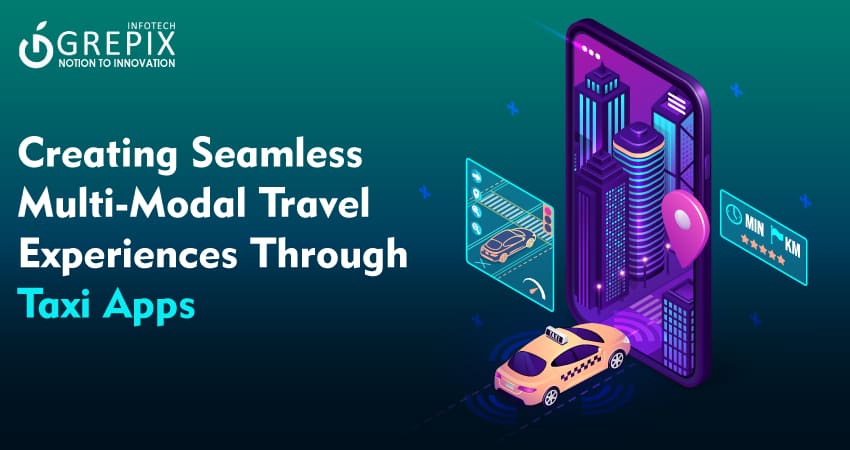Creating Seamless Multi-Modal Travel Experiences Through Taxi Apps
In today's fast-paced world, efficient and reliable transportation is more crucial than ever. Multi-modal travel, which integrates different forms of transportation into a single journey, has emerged as a key solution to urban mobility challenges. This integration promises a seamless experience for commuters, reducing travel time, cost, and environmental impact. At the forefront of this revolution are taxi apps, which have the potential to transform urban landscapes by connecting various modes of transportation through innovative technology and user-friendly interfaces.
The blog delves into the transformative impact of taxi apps on urban mobility. It highlights their role in seamlessly integrating diverse transportation modes, enhancing efficiency, sustainability, and user experience. Exploring challenges, case studies, and future prospects, it emphasizes the pivotal role of taxi apps in shaping multi-modal transportation systems. From real-time data utilization to addressing first and last-mile connectivity issues, taxi apps emerge as comprehensive mobility platforms. The blog anticipates further advancements, including AI-driven optimizations and integration of electric and autonomous vehicles, promising a smarter, more interconnected urban transportation ecosystem driven by innovation and sustainability.
The Evolution of Urban Mobility
The evolution of urban mobility reflects the changing landscapes of cities and the increasing needs of their populations. Initially dominated by footpaths and horse-drawn carriages, urban transport has transitioned through the era of trams and buses, to the widespread adoption of personal vehicles, which dramatically reshaped city planning and commuting patterns. The late 20th and early 21st centuries have seen a surge in public transit improvements and the rise of on-demand transportation services, such as taxis and rideshares, driven by digital innovation.
These developments have been supplemented by a growing emphasis on sustainable practices, leading to the integration of electric vehicles, bike-sharing programs, and pedestrian-friendly urban designs. Today, the push towards multi-modal travel solutions aims to seamlessly integrate these diverse transport options, enhancing accessibility and efficiency in urban centers while reducing environmental impacts. This ongoing transformation underscores a commitment to adapting urban mobility systems to meet the demands of modern city life and future sustainability goals.
Role of Taxi Apps in Multi-Modal Integration
Taxi apps are no longer just about booking a ride. They are evolving into comprehensive mobility platforms that facilitate connections between taxis, public transit, bike-sharing, and even walking. Here’s how taxi apps are playing a pivotal role in creating integrated travel experiences:
- Real-Time Data and Predictive Analytics: Taxi apps leverage vast amounts of data to predict traffic patterns, suggest optimal routes, and estimate travel times more accurately. This data-driven approach helps in minimizing delays and improving the overall efficiency of travel.
- First and Last Mile Connectivity: One of the biggest challenges in using public transit is the first and last mile problem — getting from your starting point to a transit station, and from the station to your final destination. Taxi apps solve this by providing timely and convenient options for these segments of a journey, making the use of public transportation more attractive.
- Unified Payment Systems: Integrating payment systems across different modes of transport simplifies the process for users, who can pay for their entire journey through a single app. This not only enhances user convenience but also encourages the use of multiple transportation modes.
- User-Centric Design and Customization: Taxi apps focus on user experience, offering personalized travel suggestions based on user history, preferences, and real-time conditions. This tailored approach makes planning multi-modal journeys more accessible and user-friendly.
Also Read: "Why inDriver Clone App Is the Best Choice for Budget-Friendly Rideshare"
Challenges in Multi-Modal Integration
Integrating multiple modes of transportation into a seamless travel experience presents several challenges, which need to be addressed to ensure the efficiency and effectiveness of multi-modal integration:
- Infrastructure and Policy: Effective multi-modal integration requires supportive infrastructure and policies that encourage collaboration between private and public transportation providers.
- Data Privacy and Security: Handling large volumes of user data necessitates robust security measures to protect privacy and build trust among users.
- Technological and Operational Coordination: Integrating different transportation systems involves complex logistical and technological challenges, including the standardization of interfaces and real-time communication between various service providers.
Case Studies
The integration of the Grab app has ushered in transformative changes in urban transportation systems, as evidenced by notable case studies worldwide. In Singapore, Grab's home turf, the app's seamless amalgamation of taxis, private cars, bicycles, and public transit has revolutionized commuting, offering unparalleled convenience and efficiency to residents and visitors alike. Meanwhile, in Jakarta, Indonesia, Grab has emerged as a lifeline for commuters grappling with the city's notorious traffic congestion.
By integrating taxis, motorcycles, and carpooling services, Grab provides real-time updates and optimized routes, significantly improving accessibility and reducing the impact of congestion on daily life. These case studies underscore Grab's pivotal role in reshaping urban mobility and enhancing the quality of transportation experiences across diverse cities.In Europe, apps like Citymapper provide real-time information and routing across various transport modes, making urban travel more manageable and less time-consuming.
The Future of Taxi Apps in Urban Mobility
The future of taxi apps in urban mobility promises to be both innovative and transformative. As cities continue to grow and evolve, the demand for efficient and sustainable transportation solutions escalates. Taxi apps, with their ability to seamlessly integrate various modes of transportation such as taxis, private cars, bikes, and public transit, are poised to play a pivotal role in addressing these challenges. Advancements in technology, including AI-driven route optimization, predictive analytics, and real-time data sharing, will further enhance the functionality and reliability of these apps.
Moreover, as electric and autonomous vehicles become more prevalent, taxi apps are likely to incorporate these emerging technologies, offering cleaner, safer, and more efficient transportation options. In the future, taxi apps will not only facilitate individual mobility but also contribute to the creation of smarter, more interconnected urban transportation ecosystems.
Conclusion
In conclusion, the future of urban mobility lies in the seamless integration of various transportation modes, and taxi apps are at the forefront of this revolution. As a leading taxi app development company, we recognize the importance of creating solutions that not only meet the evolving needs of commuters but also contribute to building smarter, more sustainable cities. Through our innovative technologies and partnerships with transportation providers, we strive to deliver seamless multi-modal travel experiences that empower individuals to navigate urban environments with ease and efficiency. Together, let us continue to embrace the potential of taxi apps in shaping the future of transportation and creating more connected and accessible cities for all.
Looking out to start your own venture like Uber? Try out our HireMe Taxi Uber Clone, the easiest way to kick-start your taxi business.








